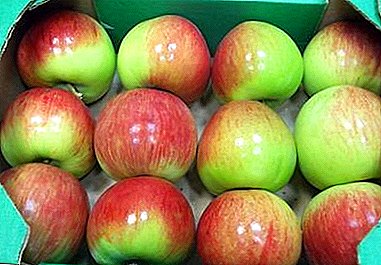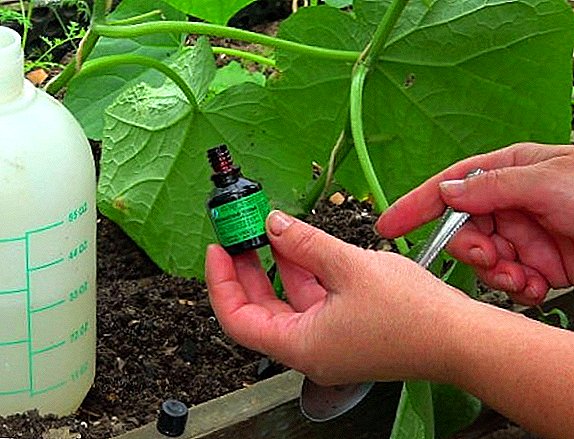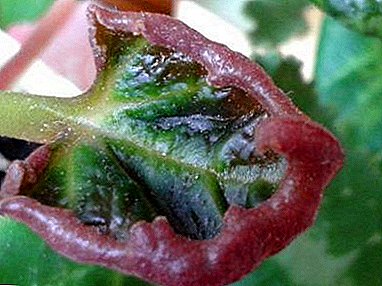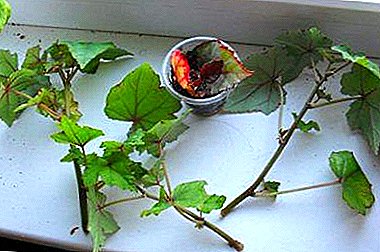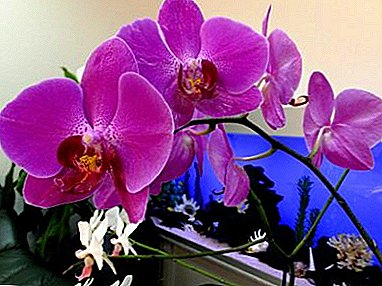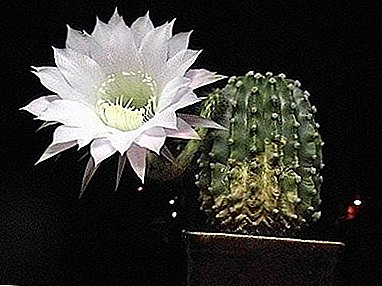 In search of exquisite ornamental plants for the garden and garden plots a lot of people prefer lush slender bushes. One of these plants is molinia, a slender, bush-like perennial that resembles a lion's mane. Moliniya is able to add a touch of savanna to any park or garden; moreover, it does not need careful care. In this article we will talk in detail about the landing and the rules for the care of the line.
In search of exquisite ornamental plants for the garden and garden plots a lot of people prefer lush slender bushes. One of these plants is molinia, a slender, bush-like perennial that resembles a lion's mane. Moliniya is able to add a touch of savanna to any park or garden; moreover, it does not need careful care. In this article we will talk in detail about the landing and the rules for the care of the line.
Botanical description
The genus of these plants is named after the Chilean botanist Juan Ignacio Molina and belongs to the family of cereals. In England, this bushy grass is called "purple marsh grass." Includes a genus of only 3 species of plants and several hybrids. However, almost all species and hybrids have similar botanical features, which allows to make a clear general characteristic of the genus.

Molinia’s roots are superficial, but creeping enough. Spreading crown, which consists of bare straight stems and fragile thin peduncles, reaches a height of 0.4-2 m. The flower stalks themselves can reach a height of more than 2.5 meters. In one bush there are so many shoots that in the middle of the crown it is almost impossible to find free space.
Important! Moline needs regular weeding. Excess weed around the bush pulls a lot of nutrients from the soil, thereby depriving the grass of its decorative.
Molini leaves do not cover shoots, they gather at the base of the bush. Rough and narrow leaves have a gray-blue color, which can sometimes acquire lighter or darker tones (depending on the type of moline). In autumn, this genus is characterized by the acquisition by leaves of a yellow or red-brown color.

The inflorescence of the purple marsh grass has a panicle shape. In our climate zone, the flowering period begins in mid-summer and does not last more than 2 months. Ripe seeds appear only at the end of August. For molinia, the slow growth of the bush remains typical. This is important for landscape design, as the plant retains its decorative qualities for a long time without direct division.
Like the miner, the family Cereals also include canary crab, reed grass, awnless bonfire, turfy pike, chumizu, Chinese miscanthus, meadow foxtail, fescue, sorghum, bison, timothy grass, hryvasty barley.
Spread
Many consider land minting a typical meadow grass.. However, it can also be found along the banks of rivers, on peatlands and in damp forests. It is found in North America, Europe, Asia. One of the varieties of molinia distributed in Japan.

Popular varieties
In decorative and landscape design, the two most valuable lines of the line are the most valuable: blue and reed.
Blue
Blue moliniya remains the leader in the list of the most popular plant species of this genus among domestic gardeners and decorators. This grass is distinguished by pointed, folded back leaves, and their tips are so sharp that together they resemble the needle sphere. The leaf blade reaches a height of 40-50 cm. Silver spikelets, which have a faint purple hue, add special beauty to the bush. It should be noted that the blue prayer line has several varieties:
- Moorhexe;
- Rotschopf;
- Heidebraut;
- Strahlenquelle.




Did you know? Moliniya was named after the Chilean H.I. Molina. However, this plant has never been found on the territory of Chile. The abbot and priest Molina was forced to move to Italy after ousting the Jesuits from Chile. In Europe, he became a professor at the University of Bologna and described some plants of this genus.
Some amateur flower growers often call the blue skyline Heidebraut (the third variety from the list). However, from a botanical point of view, such a statement is incorrect, since Hydebraut is one of the subspecies of blue molinia.
Reed
This type of bush grass is most common in the humid deciduous forests of continental Europe. The plant in the first 2 years of life quickly reaches a height of 70 cm. In subsequent years, the bush adds to both the diameter of the crown and the height. The minimum height from the foot is 110 cm. The perennial plant is characterized by the acquisition of golden-colored shoots in the autumn.
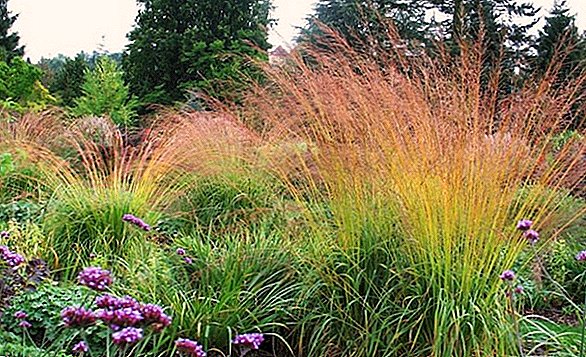
It is important to note that the inflorescences of this type have practically no decorative value, as they are painted in dark or brown shades, and at the same time they have the shape of a panicle. However, the low foliage, easily and naturally waving under the influence of the breeze, perfectly complements the upright beautiful shoots.
To decorate the garden plot, we advise you to read about how to make a mixborder, a rose garden, rock arias, a dry stream, a fountain, gabions, a waterfall, paths from saw cuts of wood and concrete, as well as a flower garden made of wheel tires and stones.
The most elegant and attractive bush looks at 2-3 years of age. From now on, he will maintain his decorative beauty for a long time, even without any other care. Reed prayer, as well as blue, has several subspecies. The most popular in decorative and landscape design remain:
- Staefa;
- Skyracer;
- Transparent;
- Fontane.




Important! Experienced flower growers and decorators recommend planting no more than 3-4 plants per 1 square meter.
The latter plant especially attracts lovers of bush-like flowers, as it resembles a frozen flowing fountain.
Application in design
This beautiful bushy grass can be grown almost everywhere. The plant is most commonly used for decorative purposes:

- as an emphasis on mixborders;
- in heather gardens;
- in the foregrounds (despite the large and voluminous crown, it remains sufficiently transparent so that through it you can view the central and background backgrounds of the landscape);
- near reservoirs (ponds, coastal zones);
- as a tamping mix of shrubs and low trees;
- in single landings on the lawn, as well as in conjunction with bush plants;
- in rosaries;
- in dry bouquets (can be created from mid-summer to the end of September).
Growing at home
The decorativeness and beauty of the line will depend largely on the proper care of it. Regular watering, fertilizer and proper wintering are the guarantee of the beauty of perennial grass.
Conditions of detention
Minerals are often grown on open soils. Planting in pots are extremely rare. This grass is a typical representative of the temperate climate zone: it tolerates snowy winters without any problems, but in summer time (especially on hot days without prolonged precipitation) it needs watering.

The genus belongs to the light-loving plants, but the penumbra is also not a particular obstacle to the development of decorative beauty. The optimum temperature regime in summer is from +18 to +25 ° С, in winter - low sub-zero temperatures, close to zero.
It will be useful for you to learn more about the different types and properties of soil, fertilizer systems for them, how to independently determine the acidity of the soil on the site, how to deoxidize it, and also find out what it depends on and how to improve soil fertility.
Soil and fertilizer
To the soil of this plant is not particularly demanding. Prefers fertile humus soils. It is important to understand that in the natural habitat of the bush grows on wet soils, so you need to get as close as possible to these conditions in home plantings. As for the acidity of the composition, molinia prefers a light soil, with a weak acid reaction. 
Complex mineral compounds can be used as fertilizers for molinia. The plant responds well to fertilizing with swollen manure, wood ash and humus. Fallen leaves, straw, spruce or pine branches, crushed stone can be used as mulch.
Watering and moisture
The intensity of irrigation will depend on the duration of the growing season of the line. In the first half of this period, experts recommend regularly watering the grass bush (2-3 times a week). Water should flow to a depth of 50 cm. In this case, it is important that the soil around the growing point should be wet all the time.

In the second half of the growing season the bush will adapt to drought and heat, therefore, watering can be reduced to 1 time per week. However, in order to preserve the decorativeness of the molinia in regions where there is almost no rainfall in the summer, watering should be done a little more often (2 times a week).
Often, well-known annuals, such as petunia, nasturtium, convolvulus, cornflowers, marigolds, are also planted in gardens.
Breeding
This plant can multiply in two ways: by seed or vegetatively. It is important to note that hybrid forms can only be propagated by vegetative means. But varietal plants can be propagated by dividing the bush (vegetatively), and seeds.
Seeds
Seeds ripen in the second half of August, during this period their collection begins. In winter, seeds are stored in a paper envelope or cloth bag in a dry, warm place, without contact with direct sunlight. Sowing of seeds is carried out in April or early May (for the northern regions). It is best to conduct a preliminary landing in peat cups. When the prayer line starts growing, it is planted on open soil with a glass.

In the southern regions, where there is no severe frost in the winter, seedlings are planted at the end of autumn (at the very beginning of winter). First, moisten the soil a little, then sow the seeds and sprinkle them with a thin layer of earth. It should be noted that in this case the planting does not need to be covered with foil, since the seeds have good hardening and will spring themselves without any problems in the spring.
Important! Parts of plants that have been damaged by pests must be removed. Otherwise, the rot will spread to healthy tissue.
Vegetative
By the vegetative way, absolutely all species and hybrid forms of molinia multiply. It is best to divide the shrub and transplant in late spring or early summer. Only adult bushes (three years old or older) can be divided, as young plants may die after transplantation. Flower growers lovers say that you can even replant individual shoots. Thus, the old bush can be properly cut, plus the whole get a large amount of planting material.

The landing hole for the separated part of the bush should not be a huge hole. Enough 30 cm deep and the same in diameter. At the bottom of the pit, you must put compost or a couple of teaspoons of complex mineral fertilizer. After planting, the separated shoot is watered (it is also possible to mulch the soil with leaves, straw or humus).
Throughout the season, such perennial plants will delight you with continuous decorativeness: host, Badan, astilba, geykher, hellebore, stonecrop, viola, tradescantia.
Wintering
Plants of this kind without any problems withstand freezing to -15 ° C. If more severe weather conditions are observed in the region, then it is recommended to cover the grass bushes with snow, pre-mulch with needles or a thick layer of leaves.

In the southern regions with temperature drops and regular precipitation in the form of rains with sleet, the mine line needs to be treated with fungicides. This is done in late autumn. The main purpose of the procedure is to protect the bush from fungal infections that develop in a humid environment at positive air and soil temperatures.
Possible difficulties in growing
When growing this ornamental plants often difficulties arise. Molinea is unpretentious in care, it endures frost and drought without any problems, and also does not need frequent watering and feeding. Purple Marsh Grass is an ideal ornamental shrub for those who cannot keep up with their home plantings.
Pests, diseases and prevention
Moliniya is very rarely damaged by various diseases and pests.. Often this happens if the grass is not treated with special preparations. Without appropriate preventive measures, Molinia can be attacked by aphids, or diseases such as powdery mildew and anthracnose.

To protect ornamental grass from fungal infections and pests, regular preventive treatments with fungicides should be carried out (especially in regions with regular precipitation, the frequency of treatments should be 1 time per month). During dry periods of summer, the spider mite can strike the ground line. But if the plant is treated with insecticides, the tick will not be able to attack it. Preventive treatment is carried out annually in spring or autumn.
Did you know? The leaf wrappers of the Molini blue inflorescences can close in a short time. The plants learned to use this property: the grass is planted to catch insect pests. Thus, the leaf wrap of the line of the line plays the role of a kind of trap.
Moline can be attacked by pests from the ground. Untreated plants may infect the grub larva. Shoots and leaf blades often attack a scoop or bark beetle. In order to prevent pests from destroying the ground line, regular preventive treatments should be carried out for shoots and root parts with preparations based on Imidacloprid. The frequency of treatments - every 40-60 days starting from mid-April.

It is quite simple to grow the ground cover on your site; even a beginner in the field of floriculture can handle it. It is important to plant the plant in the right place so that the plant is comfortable and does not disturb the overall decorative harmony of the garden plot.


